
The Dytiscidae – based on the Greek dytikos (δυτικός), "able to dive" – are the predaceous diving beetles, a family of water beetles. They occur in virtually any freshwater habitat around the world, but a few species live among leaf litter. The adults of most are between 1 and 2.5 cm (0.4–1.0 in) long, though much variation is seen between species. The European Dytiscus latissimus and Brazilian Megadytes ducalis are the largest, reaching up to 4.5 cm (1.8 in) and 4.75 cm (1.9 in) respectively. In contrast, the smallest is likely the Australian Limbodessus atypicali of subterranean waters, which only is about 0.9 mm (0.035 in) long. Most are dark brown, blackish, or dark olive in color with golden highlights in some subfamilies. The larvae are commonly known as water tigers due to their voracious appetite. They have short, but sharp mandibles and immediately upon biting, they deliver digestive enzymes into prey to suck their liquefied remains. The family includes more than 4,000 described species in numerous genera.
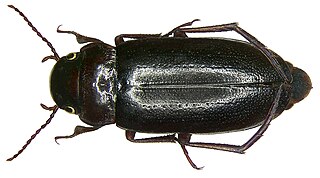
Carabdytes is a genus of predaceous diving beetles in the family Dytiscidae. Carabdytes upin was formerly the sole species of this genus, but nine species in the genus Rhantus were transferred to Carabdytes as a result of research published by Balke et al. in 2017.
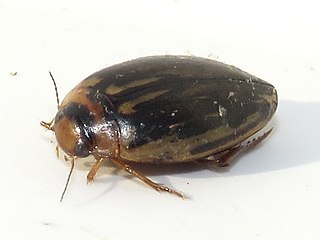
Coptotomus is a genus of predaceous diving beetles in the family Dytiscidae, the only genus of the subfamily Coptotominae. There are about six described species in Coptotomus, found in North America and the Neotropics.
Austrodytes is a genus of beetles in the family Dytiscidae found only in northern Australia. It was first described in 1978 by Chris Watts. The genus contains these two species:

Gibbidessus chipi is a species of beetle in the family Dytiscidae, the only species in the genus Gibbidessus.

Antiporus is a genus of beetles in the family Dytiscidae, first described in 1882 by David Sharp, which contains the following species:
Nirripirti is a genus of beetles in the family Dytiscidae. However the Australian Faunal Directory considers it a synonym of the genus, Paroster, on the basis of work by Leys and Watts, and Toussaint, Hendrich and others.

Helochares is a genus of water scavenger beetles in the family Hydrophilidae, represented by 161 described species. It is distributed across the Afrotropical, Australasian, Indo-Malayan, Nearctic, and Palearctic realms.
Carabdytes plantaris is a naturally uncommon species of diving beetle in the family Dytiscidae. It is endemic to New Zealand. For over a century, it was known from just a single specimen collected in 1880 "near Dunedin", and doubts were cast on whether it was actually a New Zealand species at all. In 1986, it was rediscovered when several were collected from a roadside pond near Lake Ellesmere. Carabdytes plantaris is now classed as "naturally uncommon" by the Department of Conservation.
Bidessini is a tribe of predaceous diving beetles in the family Dytiscidae. There are at least 40 genera and at least 630 described species in Bidessini.

Neobidessodes is a genus of predaceous diving beetles in the family Dytiscidae. There are about 10 described species in Neobidessodes. They are found in Australasia. The genus was first described in 2009, and the type species is N. denticulatus.
Limbodessus leysi is a carnivorous subterranean water beetle, in the Bidessini tribe of the Dytiscidae family. It was first described in 2006 by Watts and Humphreys, and the species epithet honours the entomologist, Remko Leys.
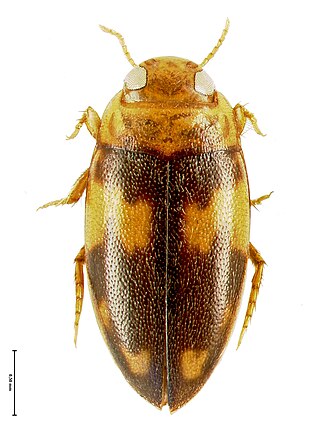
Neobidessodes flavosignatus is a carnivorous subterranean water beetle, in the Bidessini tribe of the Dytiscidae family. It was first described in 1922 by Albrecht Zimmermann as Bidessus flavosignatus. It was assigned to the genus Bidessodes by Watts in 1978, and to the new genus of Neobidessodes in 2009 by Hendrich and others.
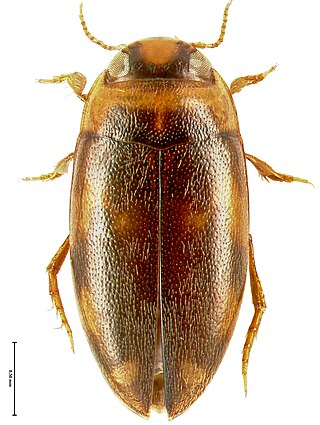
Neobidessodes mjobergi is a carnivorous subterranean water beetle, in the Bidessini tribe of the Dytiscidae family. It was first described in 1922 by Albrecht Zimmermann as Bidessus mjobergi, and reassigned to the genus of Neobidessodes in 2009 by Hendrich and others.
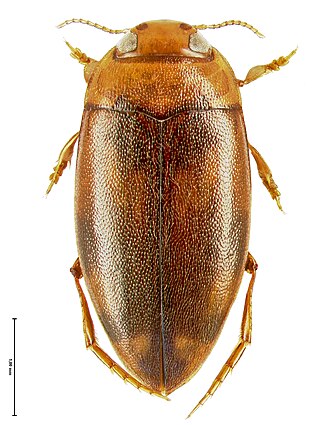
Neobidessodes grossus is a carnivorous subterranean water beetle, in the Bidessini tribe of the Dytiscidae family. It was first described in 1922 by Albrecht Zimmermann as Bidessus grossus. It was assigned to the genus Bidessodes by Watts in 1978, and to the new genus of Neobidessodes in 2009 by Hendrich and others.
Paroster caecus is blind beetle in the Hydroporini tribe of the subfamily Hydroporinae in the Dytiscidae family. It was first described by Chris Watts in 1982 as Terradessus caecus. It was transferred to the genus, Paroster, in 2016 by Toussaint, Hendrich and others.
Paroster niger is blind beetle in the Hydroporini tribe of the subfamily Hydroporinae in the Dytiscidae family. It was first described by Chris Watts in 1978.
Batrachomatus nannup is a species of diving beetle in the family, Dytiscidae, first described as Allomatus nannup in 1978 by Chris H.S. Watts. The holotype was collected in Bridgetown, Western Australia. In a generic revision in 2013, Lars Hendrich and Michael Balke synonymised AllomatusMouchamps, 1964 with Batrachomatus Clark, 1863, thus changing the species name.
Chris H.S. Watts is an Australian entomologist, who works at the South Australian Museum and specialises particularly in water beetles. He has named over 280 taxa.

Antiporus wilsoni is a beetle in the family, Antiporus, which was first described in 1978 by Chris H.S. Watts.










